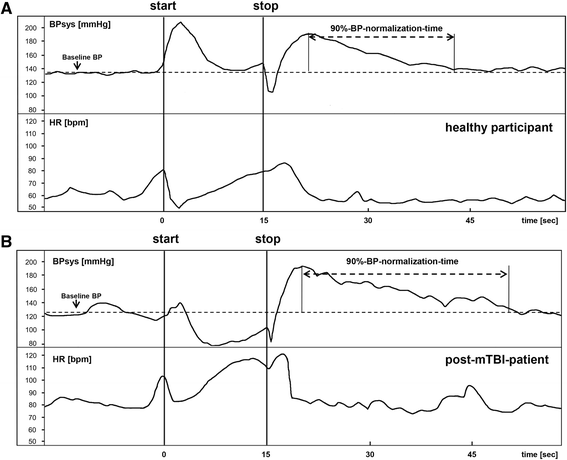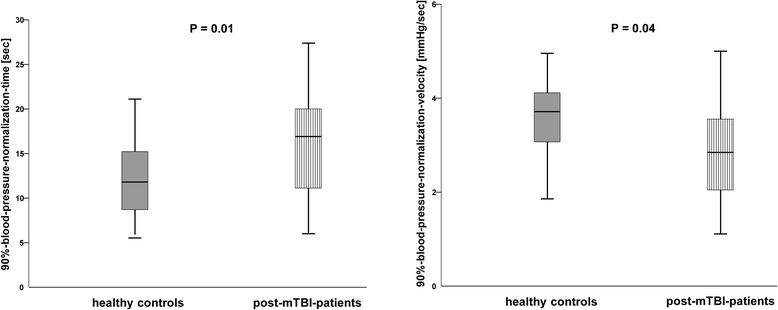Valsalva maneuver unveils central baroreflex dysfunction with altered blood pressure control in persons with a history of mild traumatic brain injury
- PMID: 27146718
- PMCID: PMC4857428
- DOI: 10.1186/s12883-016-0584-5
Valsalva maneuver unveils central baroreflex dysfunction with altered blood pressure control in persons with a history of mild traumatic brain injury
Abstract
Background: Patients with a history of mild TBI (post-mTBI-patients) have an unexplained increase in long-term mortality which might be related to central autonomic dysregulation (CAD). We investigated whether standardized baroreflex-loading, induced by a Valsalva maneuver (VM), unveils CAD in otherwise healthy post-mTBI-patients.
Methods: In 29 healthy persons (31.3 ± 12.2 years; 9 women) and 25 post-mTBI-patients (35.0 ± 13.2 years, 7 women, 4-98 months post-injury), we monitored respiration (RESP), RR-intervals (RRI) and systolic blood pressure (BP) at rest and during three VMs. At rest, we calculated parameters of total autonomic modulation [RRI-coefficient-of-variation (CV), RRI-standard-deviation (RRI-SD), RRI-total-powers], of sympathetic [RRI-low-frequency-powers (LF), BP-LF-powers] and parasympathetic modulation [square-root-of-mean-squared-differences-of-successive-RRIs (RMSSD), RRI-high-frequency-powers (HF)], the index of sympatho-vagal balance (RRI LF/HF-ratios), and baroreflex sensitivity (BRS). We calculated Valsalva-ratios (VR) and times from lowest to highest RRIs after strain (VR-time) as indices of parasympathetic activation, intervals from highest systolic BP-values after strain-release to the time when systolic BP had fallen by 90 % of the differences between peak-phase-IV-BP and baseline-BP (90 %-BP-normalization-times), and velocities of BP-normalization (90 %-BP-normalization-velocities) as indices of sympathetic withdrawal. We compared patient- and control-parameters before and during VM (Mann-Whitney-U-tests or t-tests; significance: P < 0.05).
Results: At rest, RRI-CVs, RRI-SDs, RRI-total-powers, RRI-LF-powers, BP-LF-powers, RRI-RMSSDs, RRI-HF-powers, and BRS were lower in patients than controls. During VMs, 90 %-BP-normalization-times were longer, and 90 %-BP-normalization-velocities were lower in patients than controls (P < 0.05).
Conclusions: Reduced autonomic modulation at rest and delayed BP-decrease after VM-induced baroreflex-loading indicate subtle CAD with altered baroreflex adjustment to challenge. More severe autonomic challenge might trigger more prominent cardiovascular dysregulation and thus contribute to increased mortality risk in post-mTBI-patients.
Keywords: Baroreflex dysfunction; Blood pressure overshoot; Central autonomic network; Mild traumatic brain injury; Sympathetic dysregulation; Valsalva maneuver.
Figures


Similar articles
-
Frequency analysis unveils cardiac autonomic dysfunction after mild traumatic brain injury.J Neurotrauma. 2011 Sep;28(9):1727-38. doi: 10.1089/neu.2010.1497. Epub 2011 Apr 21. J Neurotrauma. 2011. PMID: 21355816
-
Eyeball Pressure Stimulation Unveils Subtle Autonomic Cardiovascular Dysfunction in Persons with a History of Mild Traumatic Brain Injury.J Neurotrauma. 2015 Nov 15;32(22):1796-804. doi: 10.1089/neu.2014.3842. Epub 2015 Sep 23. J Neurotrauma. 2015. PMID: 26192266
-
High NIHSS values predict impairment of cardiovascular autonomic control.Stroke. 2011 Jun;42(6):1528-33. doi: 10.1161/STROKEAHA.110.607721. Epub 2011 Apr 14. Stroke. 2011. PMID: 21493903
-
Blood pressure and heart rate variability in autonomic disorders: a critical review.Clin Auton Res. 1996 Jun;6(3):171-82. doi: 10.1007/BF02281905. Clin Auton Res. 1996. PMID: 8832127 Review.
-
Beat-to-beat blood pressure and heart rate responses to the Valsalva maneuver.Clin Auton Res. 2017 Dec;27(6):361-367. doi: 10.1007/s10286-017-0474-y. Epub 2017 Oct 19. Clin Auton Res. 2017. PMID: 29052077 Free PMC article. Review.
Cited by
-
Lifelong consequences of brain injuries during development: From risk to resilience.Front Neuroendocrinol. 2019 Oct;55:100793. doi: 10.1016/j.yfrne.2019.100793. Epub 2019 Sep 24. Front Neuroendocrinol. 2019. PMID: 31560884 Free PMC article. Review.
-
The Investigation of the Cardiovascular and Sudomotor Autonomic Nervous System-A Review.Front Neurol. 2019 Feb 12;10:53. doi: 10.3389/fneur.2019.00053. eCollection 2019. Front Neurol. 2019. PMID: 30809183 Free PMC article. Review.
-
Fingolimod initiation in multiple sclerosis patients is associated with potential beneficial cardiovascular autonomic effects.Ther Adv Neurol Disord. 2017 Apr;10(4):191-209. doi: 10.1177/1756285616682936. Epub 2017 Jan 6. Ther Adv Neurol Disord. 2017. PMID: 28507603 Free PMC article.
-
Preliminary Evidence of Orthostatic Intolerance and Altered Cerebral Vascular Control Following Sport-Related Concussion.Front Neurol. 2021 Apr 9;12:620757. doi: 10.3389/fneur.2021.620757. eCollection 2021. Front Neurol. 2021. PMID: 33897587 Free PMC article.
-
Head Trauma not Associated with Long Term Effects on Autonomic Function.Int J Exerc Sci. 2021 Aug 1;14(3):779-790. doi: 10.70252/SPHO8720. eCollection 2021. Int J Exerc Sci. 2021. PMID: 34567359 Free PMC article.
References
-
- Centers for Disease Control and Prevention (CDC). Nonfatal traumatic brain injuries from sports and recreation activities--United States, 2001-2005. MMWR Morb Mortal Wkly Rep. 2007; 56(29):733–37. - PubMed
MeSH terms
LinkOut - more resources
Full Text Sources
Other Literature Sources
Medical
Research Materials
Miscellaneous

